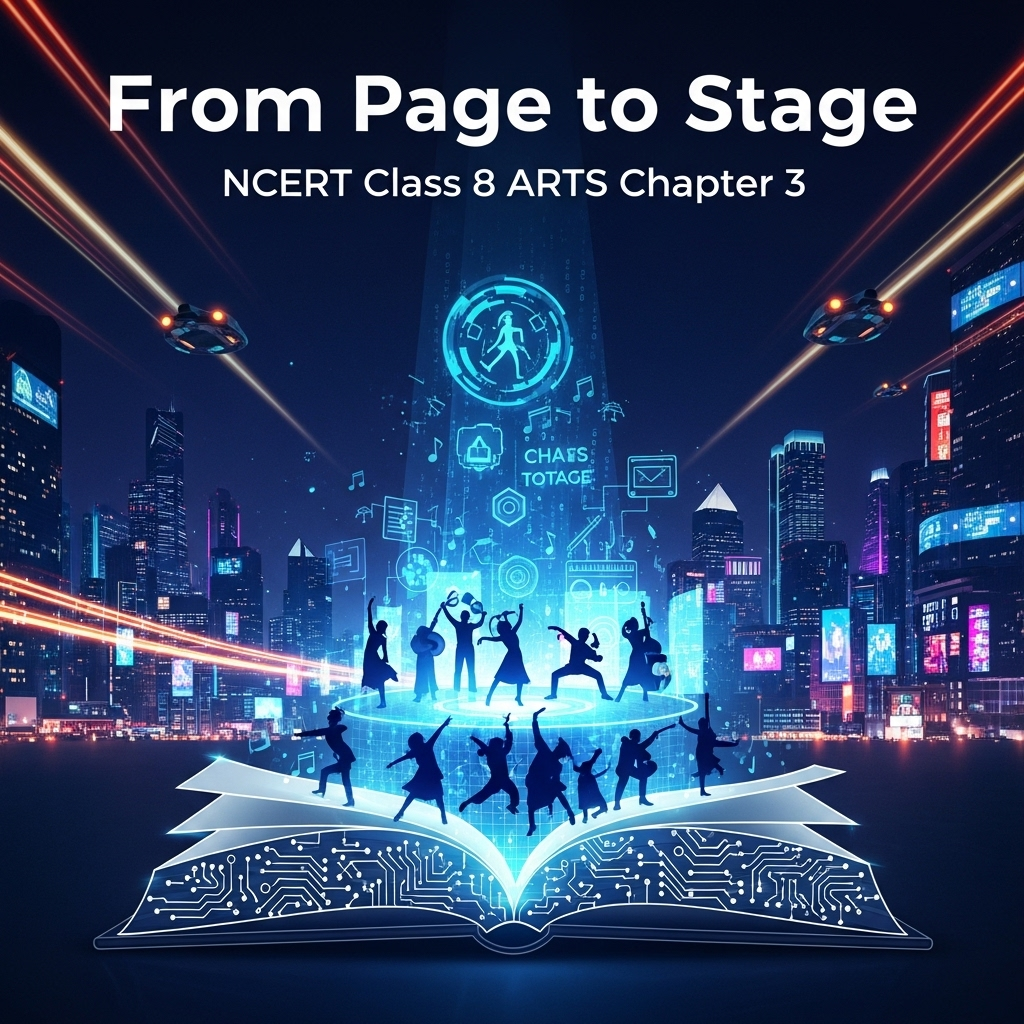Complete Solutions and Summary of From Page to Stage – NCERT Class 8, Arts, Chapter 3 – Summary, Questions, Answers, Extra Questions
Detailed summary and explanation of Chapter 3 ‘From Page to Stage’ with all question answers, extra questions, and solutions from NCERT Class VIII, Arts (Kriti).
Updated: 2 months ago

From Page to Stage
Chapter 3: Theatre-Making
Complete Study Guide with Interactive Learning
Chapter Overview
What You'll Learn
Process of Presenting a Drama
From brainstorming ideas to final performance, including rehearsals and feedback.
Elements of a Script
Understanding stage instructions, dialogues, and emotional cues in script writing.
Spirit of Theatre
Teamwork, dedication, and the motto 'The Show Must Go On'.
Integration of Arts
Incorporating dance, music, puppetry, and mime into theatre.
Chapter Context
This chapter guides Grade 8 students through theatre-making as a script about preparing a school play. It covers brainstorming, script writing, team formation, rehearsals, and performance, emphasizing teamwork and creativity.
Key Highlights
Focus on practical application with limited resources, integration of arts like puppetry and dance, and life lessons from real theatre stories, including resilience and problem-solving.
Comprehensive Chapter Summary
1. Introduction to Theatre-Making
The chapter introduces turning ideas into performances through teamwork, covering script writing, costumes, puppetry, and integration of music and dance. It's presented as a play script about Grade 8 students preparing a show.
2. Scene 1: Brainstorming
Story Selection
Students discuss and vote on stories like Savitri and Satyavan, Tenali Rama, or a Himalayan folktale, settling on one with dance and puppetry elements.
Team Formation
Teams for script, sets, costumes, puppetry, music, dance, and documentation are assigned, emphasizing everyone's involvement.
Lessons
Respect ideas, think creatively, and ensure backstage participation.
3. Scene 2: Work Begins
Script Reading and Feedback
The script is read aloud; feedback improves it, integrating arts like puppetry and folk music.
Collaboration
Patient listening and respecting work lead to a refined script.
4. Scene 3: Rehearsals and Preparation
Challenges
Arguments arise from disorganization; teacher suggests storyboards and check-ins for alignment.
5. Scene 4: First Run-through
Feedback Session
Teachers provide tips on voice projection, scene transitions, and puppetry; students plan improvements.
Mistakes and Learning
Mistakes like slow transitions are noted for refinement.
6. Scene 5: Showtime
Final checks, team prayer, and improvisation during glitches lead to a successful performance with audience applause.
7. Activities and Lessons
Thought Splash for reflections; Quiz on script elements; Motto 'The Show Must Go On' with a real-life story; Circle Time for strengths/weaknesses.
Key Concepts and Definitions
Stage Instructions
Non-dialogue lines in italics within brackets, guiding actions and visuals.
Dialogue Delivery
Emotional cues in italics after character names, indicating tone like (excited).
Teamwork in Theatre
Involvement in script, sets, costumes, puppetry, music, dance, and documentation.
The Show Must Go On
Motto for resilience, improvising despite mistakes.
Integration of Arts
Blending dance, puppetry, mime, and music into the play.
Feedback
Positive input for improvement, like voice projection and transitions.
Important Facts and Figures
Questions and Answers from Chapter
Short Questions
Q1. What is the main focus of Chapter 3?
Q2. How long is the play supposed to be?
Q3. What story do the students settle on?
Q4. Who leads the script team?
Q5. What is stage instructions?
Q6. How are non-dialogue lines formatted?
Q7. What motto is emphasized?
Q8. Who handles documentation?
Q9. What prayer is suggested?
Q10. What is a storyboard used for?
Q11. Why is feedback important?
Q12. What year is the real-life story from?
Q13. What integrates into the play?
Q14. Who saves the show in Scene 5?
Q15. What is Circle Time for?
Medium Questions
Q1. Why are non-dialogue lines in the script?
Q2. How to differentiate dialogue and non-dialogue?
Q3. How does the script indicate emotion?
Q4. What lessons from Brainstorming?
Q5. Why adhere to deadlines?
Q6. What happens in Rehearsals?
Q7. Importance of First Run-through?
Q8. What checks for Showtime?
Q9. Why 'The Show Must Go On'?
Q10. Describe the real-life story.
Q11. What is Activity 3.1?
Q12. Note to Teacher on script?
Q13. Why documentation important?
Q14. What is the prayer's meaning?
Q15. Circle Time purpose?
Long Questions
Q1. Discuss the process of presenting a drama performance as shown in the chapter.
Q2. Explain the elements of a script from Activity 3.2.
Q3. Analyze the spirit of theatre from the motto and story.
Q4. Describe Scene 1: Brainstorming in detail.
Q5. What challenges in Scene 3 and how resolved?
Q6. Evaluate the role of feedback in the process.
Q7. How does the chapter integrate arts?
Q8. Discuss the prayer and its meaning.
Q9. Explain Activity 3.1 and its purpose.
Q10. What is the table in the chapter for?
Q11. Note to Teacher's advice?
Q12. Why documentation and journaling?
Q13. Circle Time discussion points?
Q14. Describe improvisation in Showtime.
Q15. Lessons for life from chapter.
Interactive Knowledge Quiz
Test your understanding of From Page to Stage
Quick Revision Notes
Theatre Process
- Brainstorming
- Script Writing
- Rehearsals
Script Elements
- Stage Instructions
- Dialogues
- Emotions
Teams
- Script
- Puppetry
- Dance
Lessons
- Teamwork
- Feedback
- Resilience
Exam Strategy Tips
- Analyze scenes
- Understand script format
- Discuss motto
- Use table points
- Relate to activities

Group Discussions
No forum posts available.
Easily Share with Your Tribe


